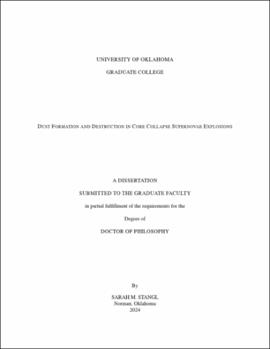| dc.contributor.advisor | Kilic, Mukremin | |
| dc.contributor.author | Stangl, Sarah | |
| dc.date.accessioned | 2024-04-22T21:15:21Z | |
| dc.date.available | 2024-04-22T21:15:21Z | |
| dc.date.issued | 2024 | |
| dc.identifier.uri | https://hdl.handle.net/11244/340232 | |
| dc.description.abstract | Dust is a crucial component of the Interstellar Medium (ISM) and an important driver in many astrophysical processes. Dust formed from evolved stars increases the metallicity of the ISM, enriching it with heavier elements. Dust makes up the source material of collapsing clouds in the ISM leading to stellar and galactic formation. The stabilization of these systems are aided by dust through absorption and scattering of excess energy. As stellar systems evolve and undergo supernova and mass loss events, enriched dust is produced, further enhancing the metallicity of the ISM. However, despite the importance of dust, the processes that produce dust are not well understood.
Core-Collapse Supernovae are one source of dust. Dying massive stars explode, sending their constituent material into the Interstellar Medium, which as the ejecta expands and cools, material condenses and nucleates forming dust grains. I investigate the formation, survivability, and properties of dust. In Chapter 2, dust grain nucleation in CCSNe is discussed. A revised formulation of Kinetic Nucleation Theory (KNT) is used to track the nucleation and growth of dust grains in the ejecta. The affects of the progenitor system on the amount and type of dust is explored, showing a strong dependence on explosion energy. I discuss the code and methods used to model dust nucle- ation and destruction in Chapter 3. The sputtering and erosion of dust grains in CCSNe shocks are explored in Chapter 4. The erosion and survival of this nucleated dust is modeled through thermal and non-thermal sputtering by the surrounding gas and shocks. The optical properties and scattering of light by surviving dust grains is modeled by Mie scattering in Chapter 5. A discussion of observations of dust in variable star systems and supernovae is outlined in Chapter 6. | en_US |
| dc.language | en_US | en_US |
| dc.rights | Attribution-NonCommercial-NoDerivatives 4.0 International | * |
| dc.rights.uri | https://creativecommons.org/licenses/by-nc-nd/4.0/ | * |
| dc.subject | Core-collapse supernovae | en_US |
| dc.subject | Astrophysical dust processes | en_US |
| dc.subject | dust formation | en_US |
| dc.subject | Lagrangian hydrocode | en_US |
| dc.title | Dust Formation and Destruction in Core Collapse Supernovae Explosions | en_US |
| dc.contributor.committeeMember | Hope, Trina | |
| dc.contributor.committeeMember | Baron, Edward | |
| dc.contributor.committeeMember | Blume, Doerte | |
| dc.contributor.committeeMember | Dai, Xinyu | |
| dc.contributor.committeeMember | Fryer, Christopher | |
| dc.contributor.committeeMember | Mauney, Christopher | |
| dc.date.manuscript | 2024-04-18 | |
| dc.thesis.degree | Ph.D. | en_US |
| ou.group | Dodge Family College of Arts and Sciences::Homer L. Dodge Department of Physics and Astronomy | en_US |
| shareok.orcid | 0000-0001-5570-6666 | en_US |

